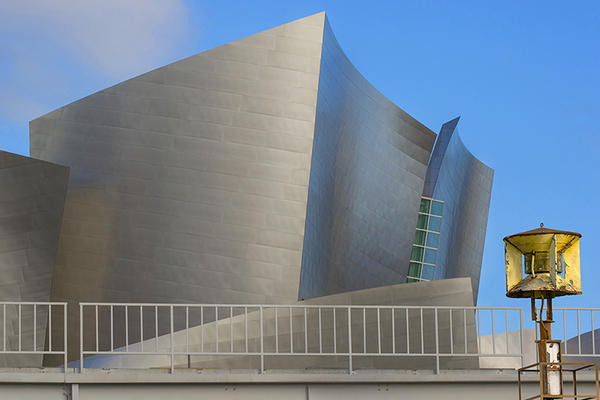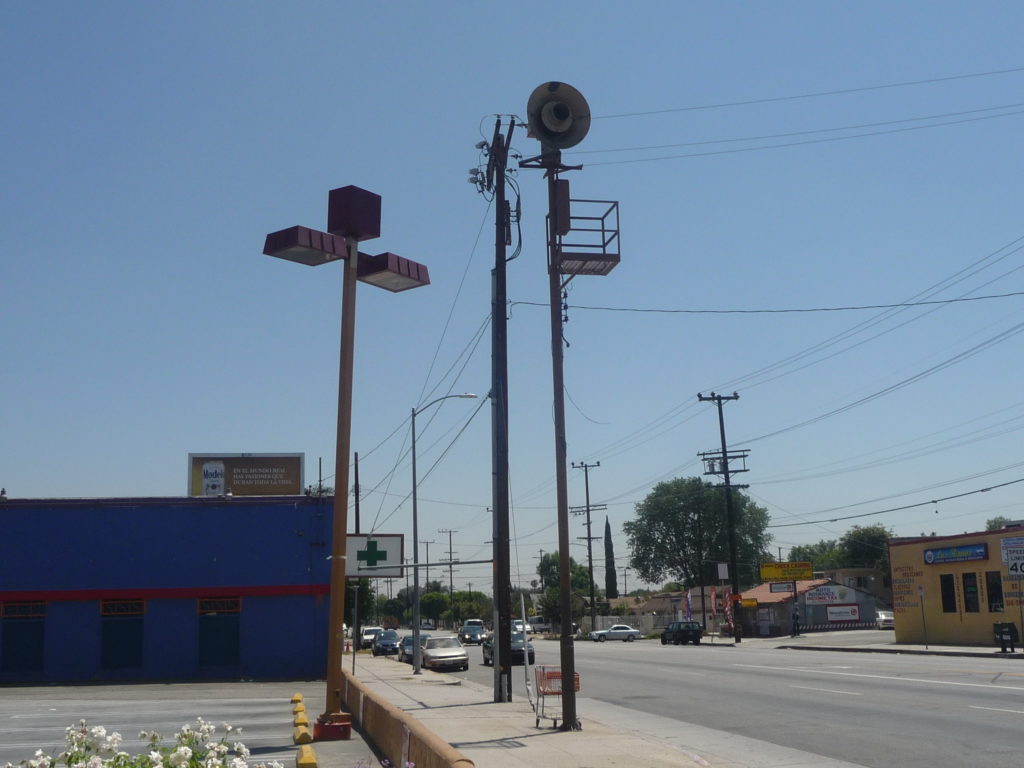The days of the civil defense siren seemed so distant just a few months ago. Yet, Los Angeles mornings once erupted with the haunting wail of these sirens regularly. And their final collective scream wasn’t as long ago as it may seem. Today, Los Angeles’s Cold War-era air raid sirens still stand sentinel across the sprawling megacity. You may have even come across one of these aging protectors as they succumb to their islands of urban decay. They’re hard to notice, largely fallen into the camouflage of the concrete jungle. But with an almost-forgotten Cold War heating up and renewed worry over nuclear attack, they’re getting our attention once again. And, this time, it’s their silence that’s screeching volumes.
The Heralding Trumpets of the City of Angels
The importance of Los Angeles to global culture is hard to deny. Can anyone really imagine a world without Hollywood? It would be like an endless sleep without dreams. We’re a city that dares the world to dream. Our value to not just America but the world gives us a feeling that we’re too big to fall. It just seems unfathomable.
But for decades, Angelenos would receive a resounding reminder of their vulnerability at 10am on the final Friday of the month. This was when the air raid sirens bellowed their sobering wail. Tests ran on this schedule to maintain the working order of the city’s civil defense sirens. But the sirens fell silent as the threat of nuclear war faded and the Cold War slipped beneath blankets of ice.
Los Angeles’s air raid siren system has not sounded since 1985. Yet, as of January 2021, over 60% of the city’s civil defense sirens still stood at attention.
The Siren Hunters of Los Angeles
While some Angeleno’s enjoy bird watching, others fall under the spell of a less conventional song. Enter Dennis Hanley, quite possibly the most prolific siren hunter in the Greater Los Angeles area. Spurred by nostalgia, Hanley painstakingly put together a comprehensive site tracking the remnants of the Los Angeles civil defense siren system.
Many sirens in states of disrepair warrant removal to make way for civic progress. It adds a certain inevitable tragedy to the city’s modest group of siren enthusiasts. Hanley diligently tracks the sirens, updating their dwindling numbers on his website.
It may seem like a thankless hobby, but Hanley’s website is strewn with messages from visitors sharing that same nostalgia. Some may be people that grew accustomed to life on the edge of a nuclear nightmare. But most seem to recall an eerie magic in their memories of those Friday morning howls. Could Los Angeles’s air raid sirens, designed to alert us to looming disasters, somehow symbolize a simpler time? It’s a familiar theme we’ve seen in the kitschy horror of Las Vegas’s National Atomic Museum we covered in a recent blog.
The History of LA’s Air Raid Siren Models
Because Los Angeles used a wide variety of air raid siren models, there’s not a uniform appearance to help siren hunters. Most look like speakers or megaphones positioned atop 30-foot-tall poles. They can be situated on sidewalks, atop buildings, on schoolyard grounds… pretty much anywhere the city could fit a siren at the time.
The first of the city’s civil defense sirens were erected during World War II, shortly following the bombing of Pearl Harbor. They even got some early use during the mysterious Battle of Los Angeles. Credited to everything from a coordinated Japanese airstrike to an extraterrestrial invasion, the 1942 incident demonstrated LA’s civil defense capabilities. But it wasn’t until the Cold War that cities around the U.S. began to install air raid sirens in record numbers.
Civil Defense Sirens in the Wake of Modern Technology
Outside of the U.S., air raid sirens were developed to be more sophisticated, offering alerts for numerous dangers. Yet, LA’s civil defense sirens offered only two audio signals: one for “alert” and another for “attack”.
With the threat of airborne attacks waning in the last few decades, many cities have found new uses for their sirens. Most are used to foretell natural disasters such as tornadoes. With Los Angeles only susceptible to earthquakes, a virtually unpredictable type of natural disaster, our air raid sirens remain without functional purpose.
On the rare occasion that an LA siren is redesigned, it’s typically with art in mind. For example, composer Lawrence English used a siren network to broadcast a vocal piece in 2018. A year earlier, the sirens were appropriately employed to broadcast H.G. Wells’ War of the Worlds.
Yet, for showing how much these air raid sirens are cherished, no example fits better than Hanley’s meticulously updated site. First published in 2006, it’s a love letter to dead machinery from an era only accessible in memories and dreams. And the siren hunters of LA love these dead sirens just as they are, wanting no more from them than what they’ve already offered.
Common Air Raid Siren Models Found Around LA
The most common air raid sirens found in the Greater Los Angeles area are as follows:
- ACA Allertor 125 – characterized by its swooping but pricey fiberglass horn.
- Chrysler Air Raid Siren – a 3-ton siren powered by a Hemi engine.
- Federal Model 5 – nicknamed the “birdhouse” for its distinctive shape.
- Federal Model 500T – nicknamed “rotating”, it offers a dual tone call.
- Federal Model SD-10 – nicknamed the “wire spool”, this is arguably the most commonly found design in Los Angeles.
- Federal Thunderbolt – an expensive Cold War-era siren designed to warn of imminent attacks.
The Call of the Air Raid Siren
If you find yourself interested in seeking out these forgotten soldiers, Hanley has made it fairly simple with his map of Los Angeles air raid sirens. Perhaps it’s easier to see them with more reverence as the parallels between the past and present become further defined. But these sentinels are indefinitely retired. These days, we carry our own personal civil defense sirens in our pockets. But smartphones are too familiar to conjure that same dedicated sense of eeriness. So, those who remember those cacophonous Friday mornings sometimes succumb to a silent call imperceptible to the rest of us. And they’ll continue chasing LA’s sirens until the only ones left are those in our memories.
With a brand that says as much as JohnHart’s, Senior Copywriter Seth Styles never finds himself at a loss for words. Responsible for maintaining the voice of the company, he spends each day drafting marketing materials, blogs, bios, and agent resources that speak from the company’s collective mind and Hart… errr, heart.
Having spent over a decade in creative roles across a variety of industries, Seth brings with him vast experience in SEO practices, digital marketing, and all manner of professional writing with particular strength in blogging, content creation, and brand building. Gratitude, passion, and sincerity remain core tenets of his unwavering work ethic. The landscape of the industry changes daily, paralleling JohnHart’s efforts to {re}define real estate, but Seth works to maintain the company’s consistent message while offering both agents and clients a new echelon of service.
When not preserving the JohnHart essence in stirring copy, Seth puts his efforts into writing and illustrating an ongoing series entitled The Death of Romance. In addition, he adores spending quality time with his girlfriend and Romeo (his long-haired chihuahua mix), watching ‘70s and ‘80s horror movies, and reading (with a particular penchant for Victorian horror novels and authors Yukio Mishima and Bret Easton Ellis). He also occasionally records music as the vocalist and songwriter for his glam rock band, Peppermint Pumpkin.





